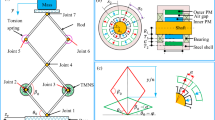Abstract
The paper focuses on the self-synchronous motion and stabilizing conditions of a vibration mechanism driven by dual-motor, which can eliminate the shimmy. The differential equations of motion of the vibration mechanism are derived by applying Lagrange’s equation and the dimensionless coupled equations of the exciters with a modified average small parameter method are obtained. The condition of existence for zero solution of the dimensionless coupled equation is used to derive the condition for the self-synchronous motion of the vibration mechanism. The stability condition of self-synchronous motion is obtained according to the Routh–Hurwitz criterion. Afterward, the numerical simulations are carried out to verify the results of the theoretical analysis. The results are concluded that increasing the mass ratio of the two exciters and decreasing the frequency ratio along the vertical direction, the angle of the resonant excitation and the mass ratio of the inner rigid body against the vibration system are all able to enhance the ability of self-synchronization of the vibration mechanism. The simulation results are finally validated by experiments.
Similar content being viewed by others
References
Huygens C.: Horologium Oscillatorium. France, Paris (1673)
Rayleigh J.: Theory of Sound. Dover, New York (1945)
Blekhman I.I., Fradkov A.L., Nijmeijer H., Pogromsky A.Y.: On self-synchronization and controlled synchronization. Syst. Control Lett. 31(5), 299–305 (1997)
Blekhman I.I., Yaroshevich N.P.: Extension of the domain of applicability of the integral stability criterion (Extremum Property) in synchronization problems. J. Appl. Math. Mech. 68(6), 839–864 (2004)
Blekhman I.I., Fradkov A.L., Tomchina O.P., Bogdanov D.E.: Self-synchronization and controlled synchronization: General definition and example design. Math. Comput. Simul. 58(4), 367–384 (2002)
Blekhman I.I.: Synchronization in Science and Technology. ASME Press, New York (1988)
Blekhman I.I.: Synchronization of Dynamical Systems. Nauka, Moscow (1971) (in Russian)
Blekhman I.I.: Vibrational Mechanics. World Scientific, Singapore (2000)
Blekhman I.I.: Selected Topics in Vibrational Mechanics. World Scientific, Singapore (2004)
Sperling L.: Selbstsynchronisation statisch und dynamisch unwuchtiger vibratoren. Teil I Grundlagen. Technische Mechanik. 14(1), 61–76 (1994) (in German)
Sperling L.: Selbstsynchronisation statisch und dynamisch unwuchtiger vibratoren. Teil II Ausführung und Beispiele. Technische Mechanik. 14(2), 85–96 (1994) (in German)
Ragulskis K.M.: Mechanisms on the Vibrating Base. Lithuanian Academy of Sciences, Kaunas (1963) (in Russian)
Ragulskis K.M., Vitkus I.I., Ragulskiene V.L.: Self-Synchronization of Systems. Self-Synchronous and Vibro-shock Systems. Mintis, Vilnius (1965) (in Russian)
Khodzhaev K.Sh.: Synchronization of the mechanical vibrators related to the linear oscillatory system. Izv. AN SSSR. MTT. 4, 14–24 (1967) (in Russian)
Nagaev R.F.: Dynamics of Synchronizing Systems. Berlin. Heidelberg: Spriger. (2003) (Engl. transl. of the Russian issue. Quasiconservative Synchronizing Systems. St. Petersburg: Nauka, 1996).
Kononenko V.O.: Vibrating System With Limited Power Supply. Illiffe, London (1969)
Balthazar J.M., Felix J.L.P., Reyolando M.L.R.: Short comments on self-synchronization of two non-ideal sources supported by a flexible portal frame structure. J. Vib. Control 10(12), 1739–1748 (2004)
Balthaza J.M., Felix J.L.P., Brasil R.M.: Some comments on the numerical simulation of self-synchronization of four non-ideal exciters. Appl. Math. Comput. 164(2), 615–625 (2005)
Author information
Authors and Affiliations
Corresponding author
Rights and permissions
About this article
Cite this article
Li, H., Liu, D., Li, Y. et al. The self-synchronous theory of a dual-motor driven vibration mechanism without shimmy. Arch Appl Mech 85, 657–673 (2015). https://doi.org/10.1007/s00419-014-0978-z
Received:
Accepted:
Published:
Issue Date:
DOI: https://doi.org/10.1007/s00419-014-0978-z




